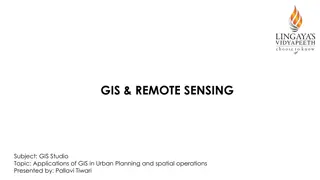Trip Planning and Hours of Service
Trip planning and hours of service regulations, including driver responsibilities, on/off duty distinctions, and math calculations for commercial vehicle operation.
Download Presentation
Please find below an Image/Link to download the presentation.
The content on the website is provided AS IS for your information and personal use only. It may not be sold, licensed, or shared on other websites without obtaining consent from the author. Download presentation by click this link. If you encounter any issues during the download, it is possible that the publisher has removed the file from their server.
- trip planning
- hours of service
- regulations
- driver responsibilities
- commercial driving
- work cycles
- math calculations
Presentation Transcript
Lesson 8 Lesson 8 Trip Planning and Hours of Service
Learning Objectives Learning Objectives After completing this lesson, you should be able to: Record and maintain a log of your hours of driving Explain hours of service regulations Demonstrate an understanding of driver and owner responsibilities regarding hours of service Explain the difference between on/off duty in a commercial driving capacity Demonstrate understanding of related rules and regulations regarding hours on/off work and work cycles. Complete basic math calculations required for commercial vehicle operation
Pre Pre- -Class Assignment Class Assignment You will have: Reviewed the textbook and answered the questions in the Exercise Book. Any questions about Lesson 7?
Trip Planning Trip Planning After completing this section, you should be able to: Identify and describe the basic purpose, importance and proper condition of the vehicle related documents Identify special requirements relating to a vehicle, load, routing or commodity Identify sources of reliable information about weather and road conditions Determine allowable axle weights, basic vehicle dimension and axle spacing requirements Complete calculations to identify compliance with vehicle requirements Explain the training required by law to perform duties properly and safely
Trip Planning Trip Planning What are the pro s of trip planning? Work/life balance Effective and efficient travel Laws
Things to Consider Things to Consider Personal identification Sleeping arrangements Electronic devices, books or entertainment Personal Vehicle documents Driver documents Shipping/cargo documents Paperwork Vehicle weight or dimension restrictions Road restrictions Driving conditions Route & Schedule
Personal Needs Personal Needs What you might need: Clothes Food and drink Toiletries Arrangements for sleeping Cash and cards Personal identification Medications Eyewear Electronic devices (i.e. cell phone) Books or other entertainment for rest periods
Paperwork and Documentation Paperwork and Documentation Vehicle Documents Driver Documents Shipping/Cargo Documents Safety Fitness Certificate Registration/ Insurance Hours of Service record Permits Trip Inspection Report Driver s licence Passport Medical certification Log book Periodic Mandatory Vehicle Inspection certificate Bills of lading Way bills Weigh slips Cargo packaging Delivery instructions
Shipping & Cargo Documents Shipping & Cargo Documents Types of shipping/cargo documents: Bills of lading: contract between shipper and customer Waybills: used with the bills of lading (invoice) Location of documentation during trip: A Transport of Dangerous Goods (TDG certificate) must be carried within your reach when you re in the cab It must be on the driver s seat, or in a pocket on the driver s door when you re not in the cab Dangerous goods have specific rules on shipping documents Specialized information and instructions Warnings and hazards 24-hour number for technical information Document storage location Shipping documents must include the shipper, carrier, customer, goods being shipped and the route.
Route and Schedule Route and Schedule Planning your route and schedule includes: Safety Hours of service regulations Fuelling, rest time, and meals Delivery deadlines Speed and efficiency Vehicle weight or dimension restrictions Daily or seasonal road restrictions Weather, traffic, and other driving conditions You are required to record the height and width of your vehicle and load in the daily vehicle inspection report.
Calculating Travel Time Calculating Travel Time Distance Distance = Speed X Time i.e. 80 km x 9 hours = 720 km Average Speed Average Speed = Distance Time i.e. 720 km 9 hours = 80 km Trip Time Trip Time = Distance average speed i.e. 720 km 80 km = 9 hours
Vehicle Vehicle Height, Width and Height, Width and Length Length Plan for places where your truck may not fit: Bridges, underpasses, and tunnels Fire escapes and doors in alleyways Tree limbs or low wires Roofs, canopies, signs, and other overhead structures Clearances for low or narrow spaces are not always posted.
Over Over- -Dimensional Loads Dimensional Loads Vehicle size is limited by regulation Permits can be issued for oversize vehicles Must meet safety regulations Require warning signage
Vehicle Weight Vehicle Weight Highways rated for truck traffic have three weight classifications: RTAC (Road Transportation Association of Canada) Class A1 Class B1 Vehicle weight is measured in two ways: Tare weight: Vehicle weight when empty Gross vehicle weight (GVW): Tare weight + cargo load weight
Road Restrictions Road Restrictions Purpose: To protect driver safety and prevent road damage Road access may be restricted because of construction, maintenance, or the season: Spring road restrictions Winter weight allowance Municipal weight restrictions Restrictions may change with 48 hours notice Restrictions can apply to vehicle dimension, weight, or both
Weather and Road Conditions Weather and Road Conditions Road conditions in Manitoba Manitoba Road and Traveller Information Call 511 Follow @MbGovRoads Weather conditions in Manitoba/Canada Environment Canada website/app Local news and radio
Other Trip Planning Considerations Other Trip Planning Considerations Ports of Entry Stop and prove the carrier has authority to operate in the jurisdiction Inspections and weighing may take place Roadside Safety Inspections drivers may be put out of service for: Hours of service violation Failed vehicle safety requirement Leaking hazardous materials Preparing for the Destination
Trip Planning Tools and Resources Trip Planning Tools and Resources There are several other tools available to help you plan your route and schedule: Dispatching system GPS CB (Citizen Band)
Exercise 1: Trip Planning Exercise 1: Trip Planning Complete Exercise 1 Time: 15 minutes
Hours of Service Hours of Service After completing this section, you should be able to: Explain that the Hours of Service regulations apply to operating any commercial vehicle Explain that driving a commercial vehicle is prohibited after accumulating 13 hours of driving in a day
Regulations for Hours of Service Regulations for Hours of Service There are federal and provincial regulations for HoS: Federal legislation applies if you operate outside Manitoba Entire fleet is affected Manitoba legislation applies to carriers and drivers operating within Manitoba Violating these regulations can result in : Fines Being taken out of service A lower safety rating for the carrier Demerits on your driver safety record
Regulation Exemptions Regulation Exemptions HoS regulations apply to all regulated trucks except: Two or three-axle trucks used by the driver/owner for their: Farming operations Forestry operations Fishing operations Emergency vehicles / Disaster relief trucks Commercial vehicles driven for personal use: The vehicle has been unloaded, and any trailers have been unhitched The distance travelled does not exceed 75 km per day Odometer reading is logged at the beginning and end of the use
On and Off Duty On and Off Duty After completing this section, you should be able to: Explain that on-duty means when driving, in care and control of a vehicle, and performing other types of work Explain that in normal conditions drivers must take 10 hours off- duty each day, and have one 24-hour period off-duty within the previous 14 days Explain that driving a commercial vehicle is prohibited after being on-duty for 14 hours in a day Explain that a work shift begins when drivers return to on-duty after being off-duty for at least 8 consecutive hours Explain that a new cycle can start only after taking the required minimum number of hours off-duty ( reset ) Explain the difference between Cycle 1 and Cycle 2
On and Off Duty On and Off Duty On-Duty: When a driver is working or is required by a carrier to be available for work Limited by days, shifts, and cycles Off-Duty: Any period other than on-duty time
Examples of On Examples of On- -Duty Work Tasks Duty Work Tasks Time: 10 minutes Make a list of 5 non-driving tasks that you think would be considered on-duty
Daily, Shift, and Cycle Limits Daily, Shift, and Cycle Limits Daily Limits (consecutive 24 hour period): Can drive 13 hours maximum Can be on-duty 14 hours maximum Must take 10 hours off-duty time Eight consecutive hours Two hours must be taken in periods of at least 30 minutes
Daily, Shift, and Cycle Limits Daily, Shift, and Cycle Limits You can defer up to two hours of off-duty time to the following day, if: The deferred time is not part of the eight consecutive hours of off-duty time on Day 1 The deferred time is added to the eight consecutive hours of off-duty time on Day 2 Total off-duty time in the two days is 20 hours minimum Total driving time in the two days is 26 hours maximum You must not drive after 13 hours of driving in a work shift.
Daily, Shift, and Cycle Limits Daily, Shift, and Cycle Limits Splitting Off-Duty Time: Single Team 4 hours min X 2 2 hours min At least 10 hours total At least 8 hours total For both single and team drivers: Must follow daily limits rules (see above) Total time immediately before and after each split off-duty period cannot exceed 16 hours None of the daily off-duty time can be deferred to the next day.
Shift Limits Shift Limits Work Shift Definition The time after your 8 consecutive hours off when you are on the job
Cycle Limits Cycle Limits Cycle Definition A series of shifts and off-duty time 120 hrs on-duty 70 hrs on-duty Cycle 2 Cycle 1 14 7 consec utive days consec utive days Must take minimum of 24 hours consecutive off- duty time before 70th hour of on-duty time
Mandatory 24 Hours Off Duty Mandatory 24 Hours Off Duty Sunday Sunday Monday Monday Tuesday Tuesday Wednesday Wednesday Thursday Thursday Friday Friday Saturday Saturday 24 hrs 24 hrs Off Off- -Duty Duty On On- -Duty Duty On On- -Duty Duty On On- -Duty Duty On On- -Duty Duty On On- -Duty Duty On On- -Duty Duty On On- -Duty Duty On On- -Duty Duty On On- -Duty Duty On On- -Duty Duty On On- -Duty Duty On On- -Duty Duty On On- -Duty Duty 24 hrs 24 hrs Off Off- -Duty Duty On On- -Duty Duty On On- -Duty Duty On On- -Duty Duty On On- -Duty Duty On On- -Duty Duty On On- -Duty Duty
Off Duty Time Deferrals Off Duty Time Deferrals
HoS Limit HoS Limit Exemptions and Overtime Exemptions and Overtime HoS can be extended in the following situations: Emergencies Adverse Driving Conditions Not extended more than 2 hours Winter Road Permits Overtime requirements vary due to your employer s policy on: Mileage Hours of Service
Log Books Log Books After completing this section, you should be able to: Maintain a complete, legible, and accurate driver s daily log (in a written or electronic format) that fully complies with the regulations Explain that the home terminal is determined by the employer and is normally associated with the location where a worker begins to drive a commercial vehicle
Daily Logs Daily Logs Information required: Name of driver(s) / carrier and your signature (end of day) Date, cycle being followed, start / end times Distance covered (odometer reading) Log grid (hours spent for each duty status) Remarks (deferring off-duty time) Supporting documents (bills of lading, shipping documents, fuel and accommodation receipts) You are required to have the current day s daily log, and records of total on-duty/off-duty hours of each of the preceding 14 consecutive days.
Filling out Grid Log Filling out Grid Log Mark beginning and end time Draw continuous line between time markers From the start to the end of the 24-hour period Record location information where status change occurs
Electronic Recording Device Electronic Recording Device Must be capable of displaying: Driving times and other on-duty times for each day Total on-duty time remaining Total on-duty time accumulated in the cycle Changes in duty status and time at which each change occurred for each day Times and dates on which the device has been disconnected and reconnected
The 160 km Radius Rule The 160 km Radius Rule The driver is exempt from having to maintain a log if: Operates within a 160 km radius of the home terminal There s no limit on the distance as long as it s within the radius Returns to the home terminal daily (minimum of 8 hours off- duty Maintains records of shift start and end times and total on-duty hours for each day (intra-provincial) Is not driving under a permit
The 160 km Radius Rule The 160 km Radius Rule Example: 160 Kilometer Radius Record 160 Kilometer Radius Record Driver name: Driver name: Date: Date: _ _ Elected Cycle: Elected Cycle: 1 1 2 2 Start Time Start Time End Time Off-Duty Driving On-Duty Driving Not Remarks Total Hours Total Hours
Tampering with Daily Logs Tampering with Daily Logs It is against the law to tamper with a daily log. Tampering includes: Keeping more than one daily log for any day Recording inaccurate information in a daily log, whether handwritten or electronically Falsifying, mutilating or defacing a driver s daily log or supporting documents Altering or tampering with original daily logs by a safety officer or any other individual Logs must be signed at end of each day to confirm information recorded is accurate.
Exercise 2: Log Books and Documents to Complete Exercise 2: Log Books and Documents to Complete Complete Exercise 2: Log Books and Documents to Complete Time: 45 minutes
Review Review What is an acceptable form of log book? Answer: Paper or electronic.
Review Review What are the 4 categories that are recorded in a log book? Answer: On-duty, off-duty, sleeper berth, on-duty not driving.
Review Review What are the cycles and how many hours are in each? Answer: Cycle 1: 70 hours of on-duty in 7 days. Cycle 2: 120 hours on-duty in 14 days.
Review Review When can a driver defer hours of the off-duty time to the following day? Answer: If they are not splitting time off-duty or inclement weather.
Review Review What is the maximum number of hours that can be deferred? Answer: 2 hours
Summary Summary You should now be able to : Record and maintain a log of hours of driving Explain hours of service regulations Demonstrate an understanding of driver and owner responsibilities regarding hours of service Complete basic mathematical calculations required for commercial vehicle operation
Quiz Quiz Lesson 8 Quiz Time: 30 minutes to complete

















































